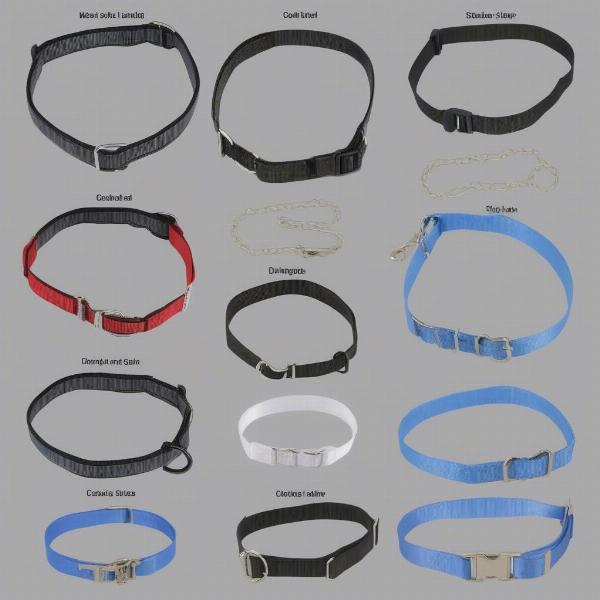Choke collars, also known as slip collars or training collars, are a controversial tool in dog training. While they can be effective in certain situations, they also pose potential risks if misused. This guide will explore the pros and cons of using a choke collar, how to choose the right one, and safe training practices to ensure your dog’s well-being. It’s important to understand the risks and responsibilities associated with using these collars before making a decision.
Understanding Choke Collars
Choke collars work by tightening around a dog’s neck when they pull on the leash. This pressure is meant to discourage pulling and encourage loose-leash walking. However, this pressure can be harmful if not used correctly. Therefore, it’s crucial to understand the mechanics of a choke collar before using one. They are not designed for continuous wear and should only be used during training sessions.
 Types of Choke Collars
Types of Choke Collars
Choosing the Right Choke Collar
When choosing a choke collar, consider your dog’s size and breed. The collar should be the correct size to fit snugly but not too tight. A properly fitted choke collar should sit high on the dog’s neck, just behind the ears. Avoid collars that are too thin or too thick, as they can be uncomfortable or ineffective. Materials also matter. Chain collars can pinch or damage a dog’s fur, while nylon may be more gentle.
Safe and Effective Training Techniques with a Choke Collar
Proper training techniques are essential for using a choke collar safely. The key is to use quick, sharp corrections followed by immediate release. Constant pressure can harm your dog’s trachea. Never yank or jerk the leash forcefully. Instead, use short, controlled pops to redirect your dog’s attention. Positive reinforcement, such as praise and treats, should always be incorporated alongside corrections to encourage desired behaviors.
Alternatives to Choke Collars
Several alternatives to choke collars offer more humane and effective training methods. Harnesses, for instance, distribute pressure across the chest and shoulders, reducing strain on the neck. Head halters provide gentle control over the dog’s head and direction. Positive reinforcement training methods, using rewards and praise, are generally considered the most effective and humane way to train a dog.
When to Avoid Choke Collars
Choke collars are not suitable for all dogs. Avoid using them on puppies, small breeds, or dogs with respiratory problems or neck injuries. They are also not recommended for dogs with aggressive tendencies, as they can exacerbate these behaviors. Consult with a certified professional dog trainer to determine if a choke collar is appropriate for your dog and to receive guidance on proper usage.
Conclusion
Choke collars can be a training tool, but their use requires careful consideration and proper training. Misuse can lead to serious injuries and behavioral problems. By understanding the risks, choosing the right collar, and employing safe training techniques, you can minimize the potential for harm. However, always consider the alternatives and prioritize your dog’s well-being. If you’re unsure, consult with a professional dog trainer to ensure the best approach for your furry friend.
FAQ
- Are choke collars cruel? While not inherently cruel, they can cause pain and injury if misused. Proper training and careful handling are essential.
- Can I leave a choke collar on my dog all the time? No, choke collars should only be used during training sessions and never left on unsupervised.
- What size choke collar should I get for my dog? Measure your dog’s neck circumference and choose a collar that fits snugly but not too tight.
- Are there better alternatives to choke collars? Yes, harnesses and head halters offer more humane and effective training options.
- What if my dog continues to pull even with a choke collar? Consult with a professional dog trainer for personalized guidance.
- Can I use a choke collar on a puppy? No, choke collars are not recommended for puppies due to their delicate necks.
- How do I introduce a choke collar to my dog? Gradually introduce the collar during positive training sessions, pairing it with treats and praise.
Related Articles on ILM Dog
About ILM Dog
ILM Dog (ilmdog.com) is your trusted resource for expert dog care advice. We offer a wealth of information on dog breeds, health, training, nutrition, grooming, and much more. Whether you’re a new dog owner or a seasoned expert, our comprehensive guides and articles provide valuable insights to help you provide the best possible care for your canine companion. From choosing the right collar to understanding your dog’s behavioral needs, ILM Dog is here to support you every step of the way. Contact us today for personalized advice: Email: [email protected], Phone: +44 20-3965-8624.